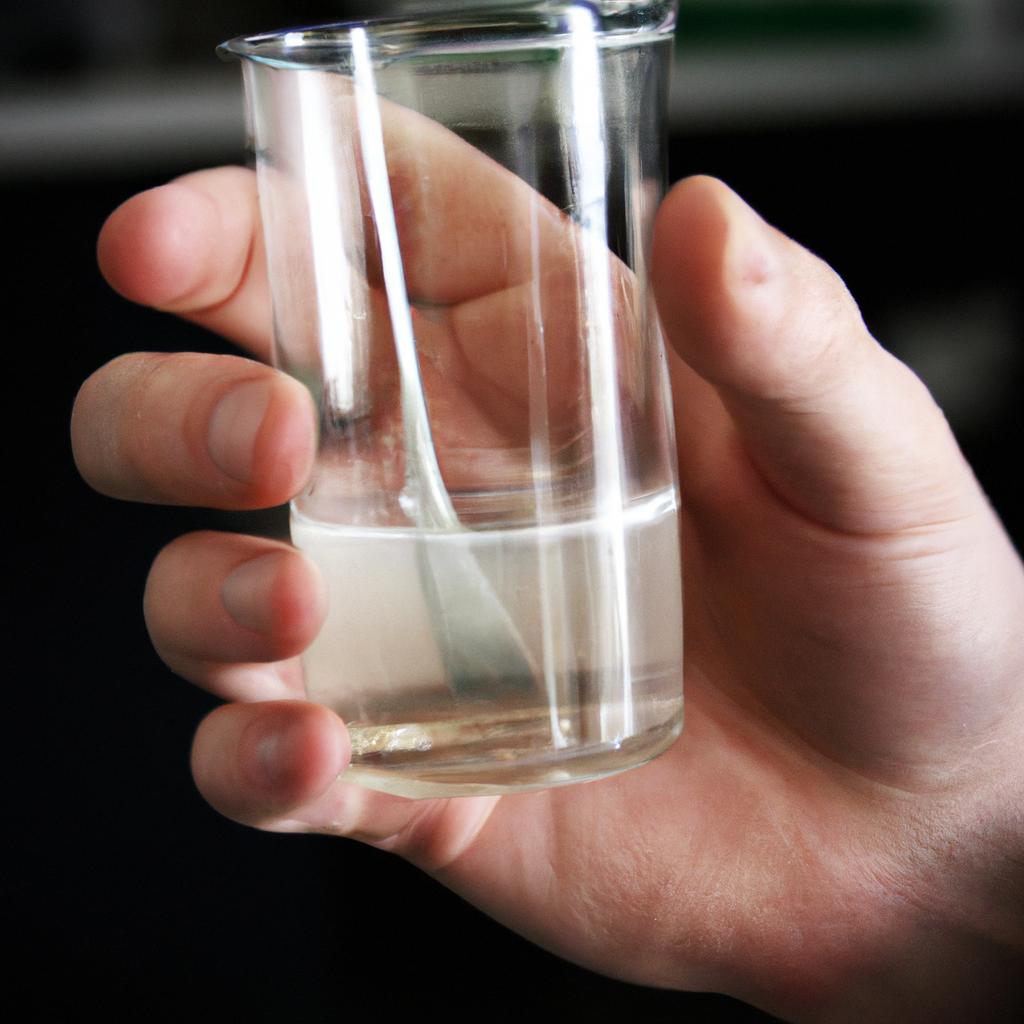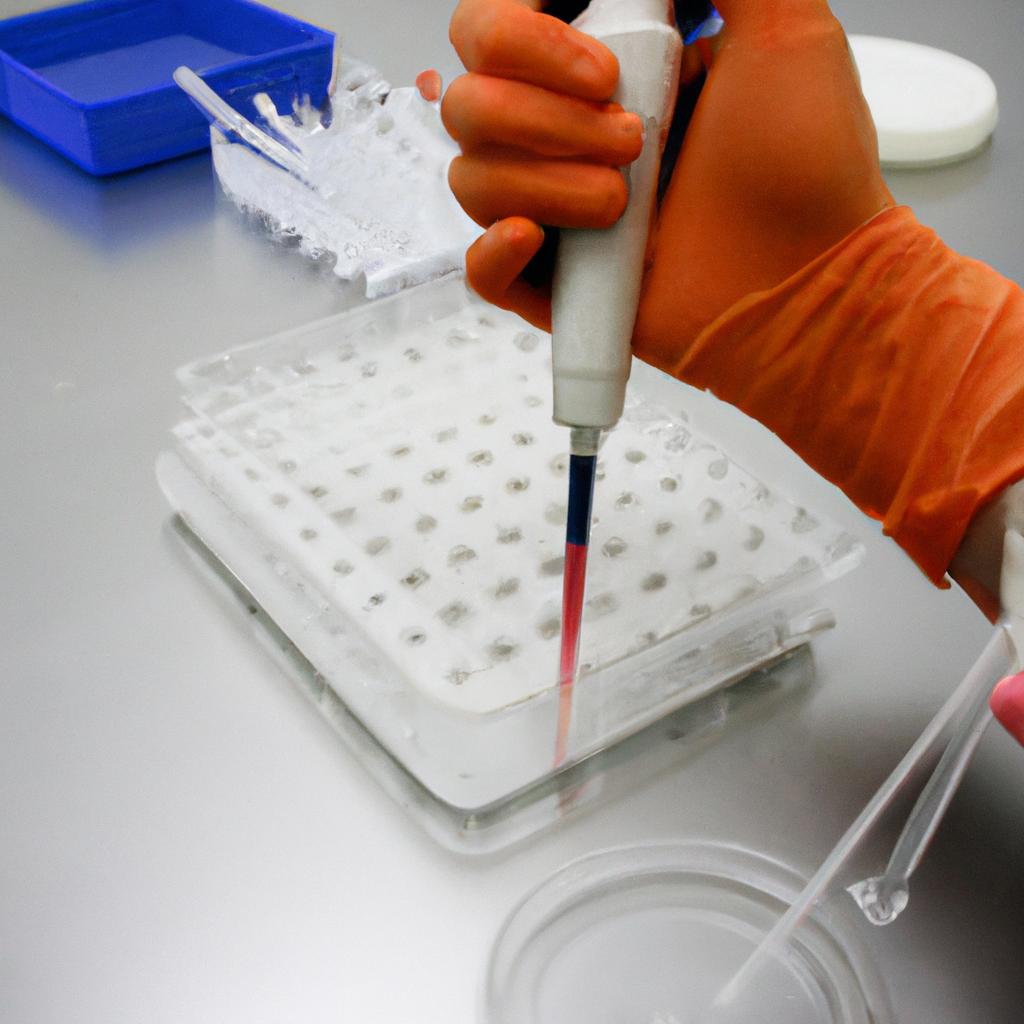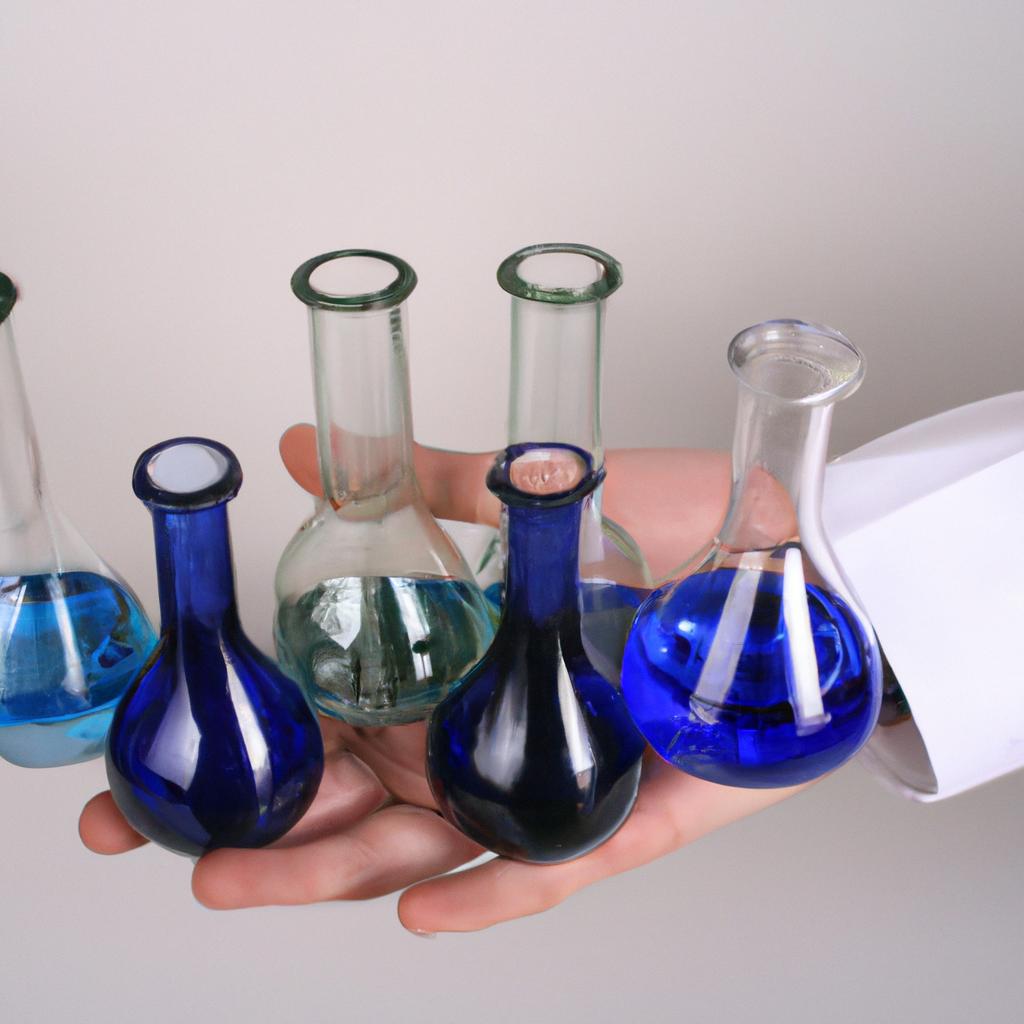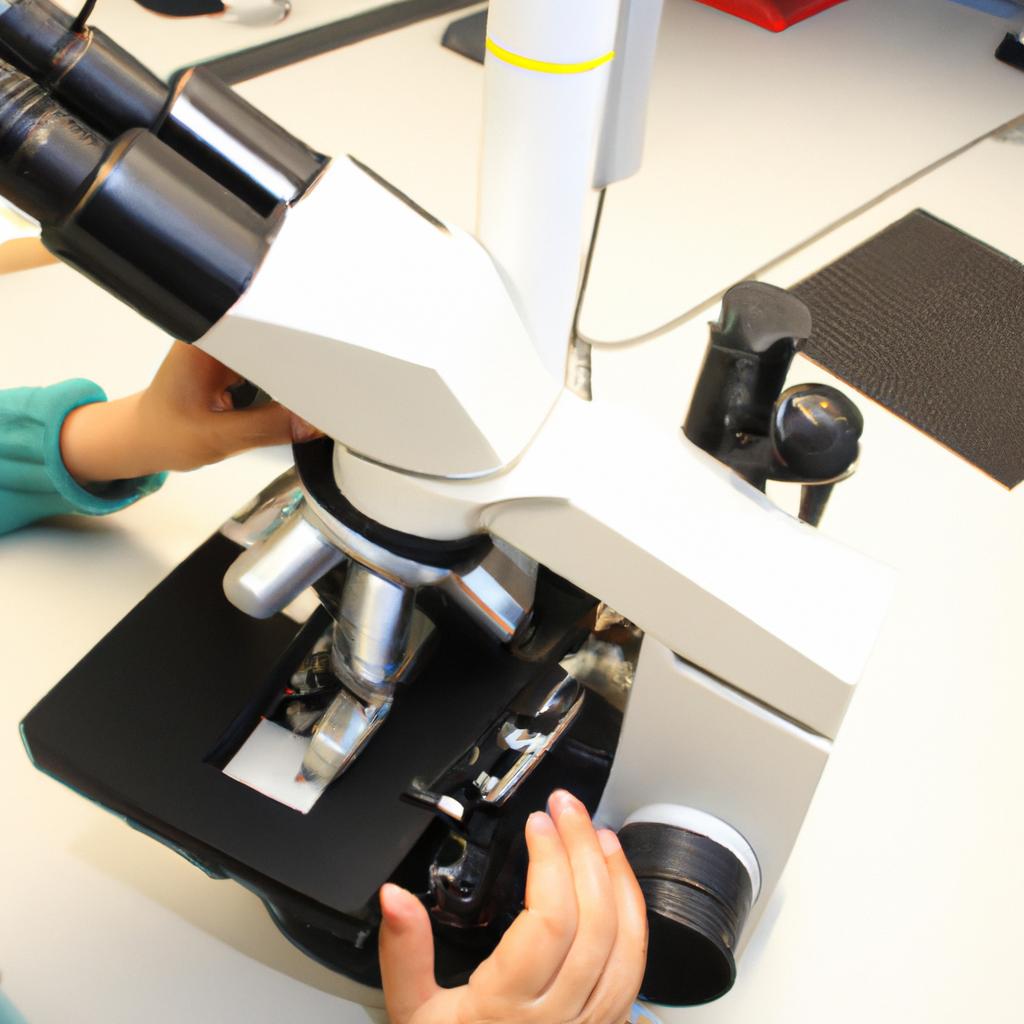Beakers are essential laboratory equipment that play a crucial role in conducting experiments and carrying out various forms of analysis. With their distinctive cylindrical shape, flat bottoms, and spouts for easy pouring, beakers provide researchers with a versatile tool to measure, mix, heat, or hold liquids during scientific investigations. For instance, imagine a chemist attempting to determine the concentration of an unknown solution through titration. The use of a beaker would enable precise measurements and controlled reactions necessary for accurate analyses. In this article, we will explore the importance of beakers in laboratory settings, discussing their design features, functions, and common applications.
In addition to their practicality in performing quantitative analyses like titrations, beakers also serve as integral components in qualitative experiments across various scientific disciplines. Their transparency allows researchers to visually observe chemical reactions as they unfold within the container. This characteristic makes them invaluable tools for studying reaction rates or observing color changes during mixing processes. Furthermore, given its wide opening at the top, a beaker facilitates efficient stirring using glass rods or magnetic stir bars – a key requirement when investigating how different substances interact with one another. Thus, understanding the significance of utilizing beakers effectively is pivotal in ensuring accurate observations and reliable experimental results throughout diverse fields such such as chemistry, biology, physics, and environmental science.
In chemistry, beakers are commonly used for preparing and measuring solutions, diluting concentrated substances, and conducting acid-base or redox reactions. They are also utilized in the synthesis of compounds and the extraction of desired components from mixtures. The transparency of beakers allows chemists to monitor changes in color or formation of precipitates during these processes.
In biology, beakers find applications in various tasks such as culturing microorganisms, preparing media for growth experiments, and carrying out enzyme assays. They can also be used for holding samples during centrifugation or storing chemicals needed for biological analyses.
In physics experiments, beakers are often employed to hold liquids that need to be heated or cooled. Their durable construction makes them suitable for withstanding temperature changes without breaking. Beakers can also aid in measuring liquid volumes or performing density measurements by displacement.
Environmental science research may involve using beakers to collect water samples from different sources for analysis. These samples can then undergo tests to determine pH levels, dissolved oxygen content, or presence of pollutants.
It is important to note that although beakers have many uses in laboratory settings, they do have limitations. Due to their cylindrical shape and lack of precise graduations on the side walls, they are not ideal for accurate volume measurements – graduated cylinders or volumetric flasks should be used instead. Additionally, because they lack lids or covers, evaporation may occur during heating processes.
Overall, understanding how to properly use and care for beakers is essential for successful experimentation across scientific disciplines. By recognizing their design features and functions within a laboratory setting, researchers can effectively utilize this versatile tool in a wide range of applications.
What are beakers and why are they important in the lab?
What are beakers and why are they important in the lab?
Beakers, cylindrical containers with a flat bottom and a pouring lip, play a crucial role in scientific experiments and analysis. They are widely used in laboratories due to their versatility and practicality. One example of their importance can be seen in chemical reactions, where precise measurements of reagents need to be made.
One key reason for the significance of beakers is their ability to hold a variety of substances. Their wide mouth allows for easy pouring and transfer of liquids or solids, making them ideal for mixing solutions or conducting precipitation reactions. Moreover, their transparency enables researchers to visually monitor changes during an experiment without disturbing the sample inside.
- Beakers come in various sizes ranging from small (50 mL) to large (5L), accommodating different quantities of materials.
- The durability of glass or plastic construction ensures resistance against chemicals commonly used in laboratory settings.
- Graduations marked on the side wall enable accurate measurement and estimation of volumes within reasonable limits.
- Some beaker designs feature handles that provide better grip while handling hot or cold substances.
Furthermore, it is worth noting that scientists often rely on standardized equipment such as beakers when comparing results across studies or replicating experiments. This standardization enhances accuracy and reproducibility, ultimately advancing scientific knowledge as a whole.
Transitioning into the subsequent section about “The different types and sizes of beakers available,” it becomes apparent how diverse these essential lab tools can be. From low-form to high-form varieties, each type serves specific purposes based on volume requirements or experimental conditions.
The different types and sizes of beakers available
Imagine a chemist working diligently in a lab, carefully measuring and mixing chemicals to create a new compound. She reaches for her trusted beaker, pours the precise amount of reactants into it, and observes the reaction unfold before her eyes. This anecdote highlights the significance of using beakers in laboratory settings. In this section, we will delve deeper into why beakers are crucial tools for experiments and analysis.
Beakers as Essential Vessels:
Beakers serve multiple purposes within the lab environment, making them indispensable for scientists across various disciplines. Here are some key reasons why beakers are important:
- Versatility: Beakers can hold liquids or solid samples during different stages of an experiment, facilitating easy observation and measurement.
- Mixing and Stirring: With their wide mouths and sturdy construction, beakers allow efficient stirring or blending of substances without risking spills.
- Heat Resistance: High-quality beakers are designed to withstand heat, allowing researchers to perform heating processes such as boiling or evaporation directly on a hot plate.
- Graduations: Most beakers come with graduated markings etched along their sides, enabling accurate volume measurements.
Emotional Bullet Point List (Markdown Format):
To emphasize the importance of using beakers in scientific research and evoke an emotional response from readers, consider these points:
- Proper experimental apparatus promotes precision and reproducibility.
- Reliable equipment ensures safety by reducing accidental chemical spillage.
- Choosing appropriate containers enhances efficiency and saves valuable resources.
- By investing in quality labware like beakers, scientists demonstrate commitment to rigorous experimentation.
Table (3 columns x 4 rows) – Advantages of Beakers:
| Advantages | Description |
|---|---|
| Versatile | Suitable for holding liquids or solids |
| Sturdy Construction | Allows for thorough mixing without spillage |
| Heat Resistant | Withstands high temperatures for heating processes |
| Graduated Markings | Enables precise volume measurements |
By understanding the versatility, mixing capabilities, heat resistance, and graduation markings of beakers, researchers can appreciate their indispensability in laboratory experiments. In the subsequent section on “How to choose the right beaker for your experiment or analysis,” we will explore factors to consider when selecting the most suitable beaker for specific scientific endeavors.
How to choose the right beaker for your experiment or analysis
Imagine you are conducting an experiment to determine the effect of temperature on enzyme activity. You have carefully designed your protocol and gathered all the necessary reagents, but now it’s time to choose the right beaker for your experiment. Making the correct selection is crucial as it can impact the accuracy and reliability of your results.
To ensure that you select the most appropriate beaker, consider the following factors:
-
Material:
- Glass beakers are ideal for most experiments due to their transparency, chemical resistance, and ability to withstand high temperatures.
- Plastic beakers are suitable when working with corrosive substances or in situations where breakage is a concern.
-
Size:
- Choose a beaker size that comfortably accommodates the volume of your solution while leaving enough headspace to prevent spills and splashes.
- Consider using multiple smaller beakers instead of one large beaker if you need to perform parallel reactions or separate samples.
-
Graduations:
- Look for beakers with clear graduations marked on the side, allowing precise measurement of liquids.
- Ensure that these markings are legible and calibrate them against a reliable standard before use.
-
Additional features:
- Some specialized beakers may have additional features like spouts or handles that facilitate pouring or handling hazardous materials safely.
Consider this hypothetical scenario: In an investigation comparing three different concentrations of a drug compound on cell viability, researchers used glass beakers with clear graduations alongside plastic beakers with spouts for easy transfer of solutions between containers. The choice of material ensured accurate measurements and reduced contamination risk during transfers.
By considering these factors when choosing a beaker, you can enhance experimental precision and minimize potential errors associated with inappropriate equipment selection.
Proper handling and care of beakers to ensure accurate results
Having chosen the right beaker for your experiment or analysis, it is crucial to handle and care for them properly in order to obtain precise and reliable results. Neglecting proper handling techniques can lead to contamination, inaccurate measurements, and even damage to the beaker itself.
To illustrate the importance of proper handling, consider a hypothetical scenario where an inexperienced researcher fails to clean a beaker thoroughly before using it for a new experiment. This oversight introduces traces of residual substances from a previous experiment into the current one, resulting in misleading data. By highlighting this example, we emphasize the significance of following correct procedures when working with beakers.
In order to prevent such mishaps and maintain accuracy throughout your experiments or analyses involving beakers, here are some essential guidelines:
- Always wash beakers before use: Thoroughly rinse each beaker with distilled water followed by an appropriate cleaning agent specific to the type of residue present.
- Avoid direct heat contact: Beakers should not come into direct contact with flame or heat sources without proper protection like wire gauze or ceramic platforms.
- Use caution during stirring: When employing magnetic stirrers or any other method that involves stirring inside the beaker, exercise caution to avoid damaging its surface.
- Handle with care: Be mindful while transporting or transferring liquids between beakers to minimize spills or breakages.
Additionally, you may find it helpful to refer to the table below which summarizes key do’s and don’ts when handling beakers:
| Do’s | Don’ts |
|---|---|
| Wear protective gloves | Place hot glassware directly on cold surfaces |
| Inspect for cracks or chips | Pour corrosive chemicals down the drain |
| Clean immediately after use | Stack wet glassware |
| Store in designated areas | Use abrasive materials on glass surfaces |
By adhering to these guidelines and exercising caution, you can ensure the integrity of your experiments or analyses. Remember that proper handling and care of beakers not only safeguards accurate results but also promotes a safe laboratory environment.
With an understanding of how to handle and maintain beakers properly, we can now explore their common uses in various scientific disciplines.
Common uses of beakers in various scientific disciplines
Proper handling and care of beakers is crucial in achieving accurate results in scientific experiments and analysis. Understanding the common uses of beakers across various scientific disciplines can provide valuable insight into their importance as essential lab equipment.
For instance, in chemistry labs, beakers are commonly used for mixing solutions or reagents. A hypothetical scenario could involve a chemist conducting an experiment to determine the concentration of a particular substance in a solution. By carefully measuring and transferring the solution into a beaker, they can accurately analyze its properties using appropriate techniques.
To further illustrate the significance of beakers, consider these examples:
- In biology laboratories, researchers may use beakers to store and culture cell cultures. This allows them to observe cellular growth and behavior under controlled conditions.
- Geologists often utilize beakers to process rock samples during mineralogical analyses. They may dissolve certain minerals in acids within a beaker, enabling the extraction of specific elements for further study.
- Environmental scientists might employ beakers when analyzing water samples from different sources. By comparing the physical and chemical characteristics observed in multiple beakers simultaneously, they can identify potential contaminants or variations between samples.
These diverse applications exemplify how versatile and indispensable beakers are throughout scientific research. To emphasize this point further, consider the following bullet-point list:
- Beakers facilitate precise measurements through clearly marked volume graduations.
- Their durable construction ensures resistance to heat, chemicals, and mechanical stress.
- The wide mouth design allows for easy pouring, transferal, and efficient mixing.
- Available in various sizes ranging from small-scale experiments to large-scale productions.
Additionally, let’s include a table showcasing some features of different types of beakers:
| Type | Features | Applications |
|---|---|---|
| Glass | Transparent; resistant to most chemicals | General laboratory use |
| Plastic | Lightweight; shatterproof | Fieldwork or situations requiring mobility |
| Stainless Steel | Durable; withstands high temperatures | High-temperature experiments |
In conclusion, beakers play an integral role in scientific experimentation and analysis across multiple disciplines. By understanding their proper handling, care, and common uses, researchers can ensure accurate results throughout their work. The next section will focus on the safety precautions necessary when using beakers in a laboratory setting.
Being aware of these applications is essential, but it is equally important to prioritize safety while utilizing beakers in the lab environment.
Safety precautions when using beakers in the lab
Transitioning from the previous section, where we explored the common uses of beakers across various scientific disciplines, let us now delve into the crucial topic of safety precautions when utilizing these essential lab tools. To illustrate the significance of proper beaker usage, let’s consider a hypothetical scenario involving a chemistry experiment that went awry due to negligence.
Imagine a researcher working on synthesizing a new compound by heating different reagents in a beaker over an open flame. Unfortunately, they fail to take necessary precautions and neglect to use a heat-resistant mat or wear protective gloves. As a result, the intense heat causes the beaker to crack suddenly, splattering hazardous chemicals onto their skin and causing severe burns.
To prevent such accidents from occurring, it is imperative for laboratory personnel to adopt strict safety measures when using beakers. Here are some key points to remember:
- Proper handling: Always hold the beaker securely while pouring and avoid sudden movements.
- Suitable storage: Store beakers upright in designated areas away from edges or overcrowded spaces.
- Temperature control: Never subject glass or plastic beakers directly to extreme temperature changes as this can cause breakage.
- Chemical compatibility: Ensure that the materials being used within the beaker are compatible with its construction material (e.g., corrosive substances should not come into contact with certain types of glass).
In considering safety guidelines for using beakers effectively, it is beneficial to present information visually as well. The following table provides an overview of potential risks associated with improper usage and corresponding precautionary measures:
| Risk | Precautionary Measure |
|---|---|
| Burns | Wear appropriate protective clothing |
| Chemical spills | Use secondary containment systems |
| Glass breakage | Utilize heat-resistant mats |
| Incompatible chemicals | Check chemical compatibility before mixing |
By adhering to these safety precautions, laboratory personnel can significantly reduce the likelihood of accidents and ensure a safe working environment. It is imperative that researchers prioritize their well-being by following proper protocols when handling beakers or any other lab equipment.
In conclusion, maintaining safety in the laboratory requires meticulous attention to detail and adherence to established guidelines for using beakers. By understanding potential risks and implementing necessary precautionary measures, researchers can protect themselves and others from harm while conducting experiments and analysis.




